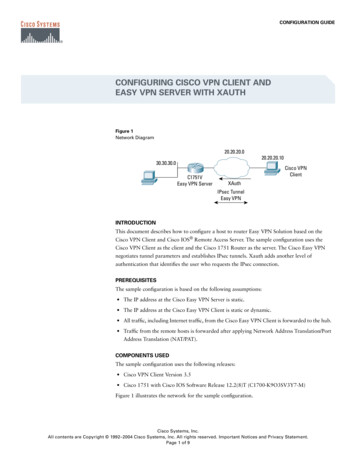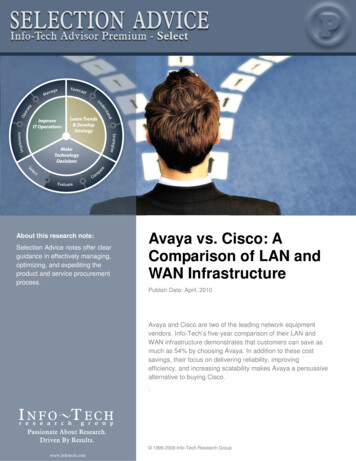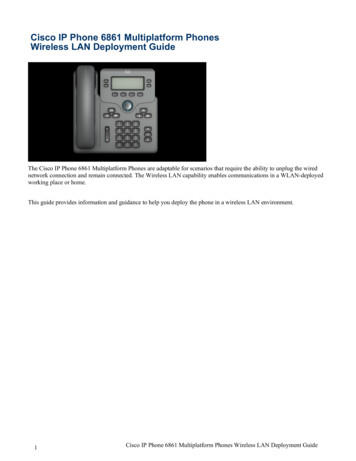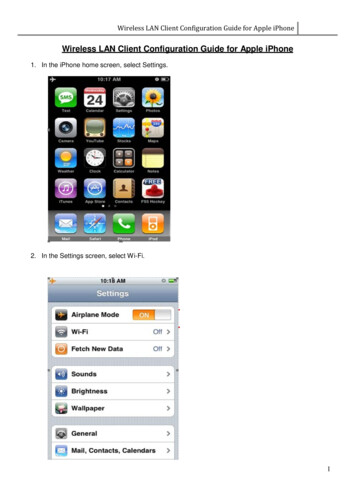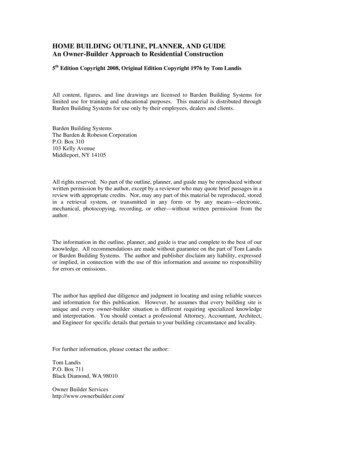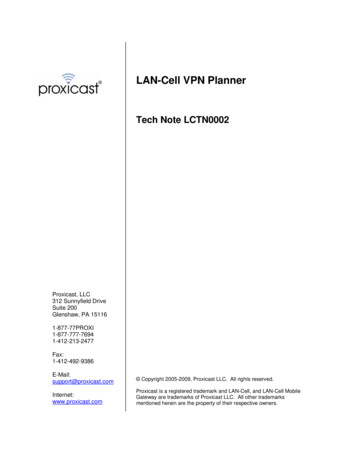
Transcription
LAN-Cell VPN PlannerTech Note LCTN0002Proxicast, LLC312 Sunnyfield DriveSuite 200Glenshaw, PA 1-412-492-9386E-Mail:support@proxicast.com Copyright 2005-2009, Proxicast LLC. All rights reserved.Internet:www.proxicast.comProxicast is a registered trademark and LAN-Cell, and LAN-Cell MobileGateway are trademarks of Proxicast LLC. All other trademarksmentioned herein are the property of their respective owners.
LCTN0002: LAN-Cell VPN PlannerThis Tech Note applies to LAN-Cell models:LAN-Cell 2:LC2-411CDMA:1xMG-4011xMG-401SGSM:GPRS-401Minimum LAN-Cell Firmware Revision: 3.62(XF2).Note for Original LAN-Cell Model (1xMG & GPRS) Users:The VPN configuration screens in the original LAN-Cell’s Web GUI differ slightly from the examples in thisTechnote. Please locate the corresponding parameter fields in the VPN Configuration section of the LAN-Cell’suser interface under VPN Rules (IKE). See also the LAN-Cell’s User Guide for more information on VPNconfiguration.Document Revision History:DateFebruaru 6, 2009July 14, 2008CommentsFixed typographical errors. Added reference to Proxicast VPN Client.First releasePage 1
LCTN0002: LAN-Cell VPN PlannerIntroductionConfiguring an IPSec VPN connection between two devices from different manufacturers can be challengingsince manufacturers sometimes use different descriptions for the same parameters. Also, the user must gather alarge number of network address and security related parameters in order to complete the configuration. In someinstances, it may not be possible or expedient to change the configuration of one VPN end device, necessitatingthat the other device be configured to match some pre-existing parameters.The LAN-Cell contains IPSec VPN client and server functionality and is interoperable with most other IPSec VPNequipment and software.The LAN-Cell can establish “site-to-site” VPN tunnels with other VPN hardware devices; it also supports “client-tosite” tunnels from single remote PC’s running VPN client software. This TechNote includes worksheets for thesite-to-site type of VPN setup. See the Proxicast Support website for examples of configuring client-to-site VPNtunnels using the LAN-Cell as the VPN server with VPN client software such as the Proxicast IPSec VPN Clientfor Microsoft Windows. The LAN-Cell can also be a single-point client to a remote VPN, but this configuration isnot common and is not included in the examples.This TechNote is designed to help you gather the information necessary to configure a virtual private networkbetween your LAN-Cell and your existing VPN equipment. Included are complete VPN example configurations,LAN-Cell VPN default values along with blank worksheets for you to record your specific settings. Use theworksheets in this document to plan your VPN deployment before beginning to make changes to either VPNdevice.Getting StartedSome key points to remember when configuring your VPN: In general, all VPN parameters much match EXACTLY between the 2 devices. It is helpful to can have simultaneous access to the to parameter and log screens of both devices duringsetup and testing. The network on the LAN side of the LAN-Cell and on the “private” side of your other VPN equipment mustbe on different subnets. Most users find it easiest to configure VPNs if both end-points have static public IP addresses. Contactyour ISP or cellular network operator to determine if static IP addresses are available. Otherwise, you willneed to define a Dynamic DNS hostname for your VPN equipment that has a dynamic IP address. The LAN-Cell can be either the VPN initiator or responder for site-to-site VPNs. It is the responder forclient-to-site VPNs. Ensure that your VPN device is configured for IPSec VPN tunnels and not PPTP, L2TP, or GRE as theseare not supported by the LAN-Cell at this time (you can implement these tunneling protocols on a device“behind” the LAN-Cell and configure the LAN-Cell to support “pass-through” tunneling).Please see the LAN-Cell User’s Guide or more detailed information on the VPN parameters and configuration.Also see the Proxicast Support website (http://www.proxicast.com/support) for additional VPN information andconfiguration examples.Page 2
LCTN0002: LAN-Cell VPN PlannerSite-to-Site VPNsSite-to-Site VPNs are probably the most common way to set up a secure connection to a remote site. The IPSectunnel will be established between the LAN-Cell and a corresponding VPN router/firewall/concentrator on your“headquarters” network (e.g. Cisco PIX/ASA, SonicWall, CheckPoint, etc.).A site-to-site VPN tunnel results in the “private” subnets behind each VPN device being able to communicate witheach other directly and securely as if they were on the same physical network.Figure 1 shows the IP addressing for our example site-to-site VPN configuration. Note that the remote site(LAN-Cell) has both a static IP address as well as a dynamic DNS name defined. Some VPN devices canestablish connections to dynamic DNS devices; others must use static IP addresses. The LAN-Cell supportsDynamic DNS hostnames for its own WAN IP address as well as its peer VPN gateway.Figure 2 is for you to record the network addresses of the key nodes in your VPN network.Figure 1: Example Site-to-Site VPN Network TopologyFigure 2: Your Site-to-Site VPN Network TopologyPage 3
LCTN0002: LAN-Cell VPN PlannerSite-to-Site VPN ParametersThe LAN-Cell’s VPN parameters are divided into Gateway Policy and Network Policy components.The Gateway Policy (IKE) parameters define how the LAN-Cell and the other VPN device should contact eachother over the Internet and the security parameters required for them to establish trusted communications.Network Policy (IPsec) parameters define which LAN devices are allowed to communicate through the VPN, howeach VPN device should integrate the other’s private subnet into their routing tables and how communications areto be secured.The next 2 pages contain worksheets for both the Gateway and Network Policy parameters. Each parameter isshown with its default value, along with the value used in our example site-to-site VPN. Space is also provided foryou to record the settings appropriate for your VPN configuration. We recommend that you complete theseworksheets before beginning your VPN configuration setup.Table 1 summarizes the Gateway Policy parameters which must be defined first when creating a new VPNconnection with the LAN-Cell. The LAN-Cell 2 supports a number of advanced options such as High Availability(fail-over) tunneling, X.509 PKI certificates and multiple IKE proposals. These have been omitted in the interest ofsimplicity for this example. This example also assumes that IKE is used rather than manual key exchange.Table 2 summarizes the Network Policy parameters. Each Gateway Policy can have one or more associatedNetwork Policies and Network Policies can be moved between Gateway Policies if necessary.Please refer to the notes following each table for additional information on each VPN parameter.Page 4
LCTN0002: LAN-Cell VPN PlannerTable 1: Site-to-Site Gateway Policy (IKE) Parameters#Parameter1Gateway Policy Name23456789101112131415NAT TraversalMy AddressPrimary Remote GWPre-Shared KeyLocal ID TypeLocal ID ContentPeer ID TypePeer ID ContentExtendedAuthentication(XAUTH)Negotiation ModeEncryption AlgorithmAuthenticationAlgorithmSA LifetimeKey n IP192.168.1.1IP10.1.1.1OffExampleHQ VPN 800DH1 (768)28800DH128800DH1YourLAN-CellN/AYourHQ VPNN/ATable 1 Notes:1.Gateway Policy Name is required.2.NAT Traversal may be necessary if your HQ VPN device is behind a NAT’ing router.3.If My Address is left at 0.0.0.0, the LAN-Cell inserts the current WAN IP address. Use this for dynamic IP situationswhere you do not have a DDNS name defined, otherwise, select one of the DDNS names you have previouslydefined in the LAN-Cell for your dynamic IP interface.4.This is the public WAN IP address of your HQ VPN device (or its FQDN).5.Key values must be 8 to 31 case-sensitive ASCII characters or from 16 to 62 hexadecimal ("0-9", "A-F" prefixed by“0x”) characters and match exactly on both devices.6.through 9. The ID type can be IP address, domain name, or e-mail address, and the ID content is a specific IPaddress, domain name, or e-mail address. The ID content is only used for identification; the IP address, domainname, or e-mail address that you enter does not have to actually exist. The LAN-Cell automatically uses the IPaddress in the My LAN-Cell field if you configure the local Content field to 0.0.0.0 or leave it blank. Local ID type andcontent refers to the ID type and content that applies to the LAN-Cell itself, and peer ID type and content refers to theother router in the IKE SA. Note: The LAN-Cell's local and peer ID type and ID content must match the remote IPSecrouter's peer and local ID type and ID content, respectively. IP type is sometimes known as “address matching”.10. XAUTH implementations vary by vendor. We suggest setting up your initial VPN without XAUTH to ensure that allother parameters are correct.11. Main mode provides more security; Aggressive mode results in faster tunnel setup.12. DES (56 bit), 3DES (168 bit) and AES (128 bit) are supported. The LAN-Cell and the remote IPSec router must usethe same algorithms and keys. Longer keys increase latency and decrease throughput.13. SHA1 is generally considered stronger than MD5, but it is also slower.14. Length of time before an IKE SA automatically renegotiates ranging from 180 to 3,000,000 seconds (almost 35 days).Short SA Lifetimes increase security by forcing the two VPN gateways to update keys. However, every time the VPNtunnel renegotiates, all users accessing remote resources are temporarily disconnected.15. Diffie-Hellman DH1 768 bits; DH2 1024 bits.Page 5
LCTN0002: LAN-Cell VPN PlannerTable 2: Site-to-Site Network Policy (IPSec) Parameters#Parameter123456ActiveNameProtocolNailed UpAllow NetBIOSCheck IPsecConnectivityGateway PolicyLocal Address TypeLocal Start IPLocal End IP / MaskRemote Address TypeRemote Start IPRemote End IP / MaskEncapsulation ModeActive ProtocolEncryption AlgorithmAuthentication AlgorithmSA LifetimePerfect ForwardSecrecyEnable ReplayDetectionEnable YesMain Office LAN0NoNoNoExampleHQ o Main ESSHA128800NoneNoNoNoNoNoNoYourLAN-CellYourHQ VPNN/AN/ATable 2 Notes:1.If the Active check box is selected, packets destined for the HQ LAN trigger the LAN-Cell to build the tunnel. Thetunnel does not come up automatically until a matching packet is received or Nailed Up is selected.2.Network Policy Name is required.3.0 signifies that any protocol is permitted through the tunnel.4.Turn on Nailed Pp to have the LAN-Cell automatically reinitiate the SA after the SA lifetime times out, even if there isno traffic. The LAN-Cell also reinitiates the SA when it restarts. The LAN-Cell also rebuilds the tunnel if it wasdisconnected due to the output or input idle timer expiring. This option keeps the tunnel up at all times.5.If checked, allows NetBIOS traffic to pass through the tunnel.6.Check this box and configure an IP address in the Ping this Address field to have the LAN-Cell test the VPN tunnel tothe remote IPSec router every minute. The LAN-Cell starts the IPSec connection idle timeout timer when it sends theping packet. If there is no traffic from the remote IPSec router by the time the timeout period expires (default is 2minutes), the LAN-Cell disconnects the VPN tunnel. Also known as “dead peer detection”.7.Gateway Policy to which this Network Policy is bound.8.through 13. Specify the IP addresses of the devices behind each VPN device that can use the VPN tunnel. The localIP addresses must correspond to the remote IPSec router's configured remote IP addresses. If “subnet” is selectedas the type, be sure to specify a subnet address rather than a specific IP address; for example to specify the entireclass-C subnet, specify 192.168.1.0 / 255.255.255.0 as the local subnet and mask.14. Select Tunnel or Transport.15. Select ESP or AH.16. DES (56 bit), 3DES (168 bit) and AES (128 bit) are supported. The LAN-Cell and the remote IPSec router must usethe same algorithms and keys. Longer keys increase latency and decrease throughput.Page 6
LCTN0002: LAN-Cell VPN Planner17. SHA1 is generally considered stronger than MD5, but it is also slower.18. Length of time before an IKE SA automatically renegotiates ranging from 180 to 3,000,000 seconds (almost 35 days).Short SA Lifetimes increase security by forcing the two VPN gateways to update keys. However, every time the VPNtunnel renegotiates, all users accessing remote resources are temporarily disconnected.19. PFS changes the root key that is used to generate encryption keys for each IPSec SA. It is more secure but takesmore time. Diffie-Hellman DH1 768 bits; DH2 1024 bits.20. Select to enable replay attack detection (denial of service).21. Select to allow the LAN-Cell to use any of its phase 2 encryption and authentication algorithms when negotiating anIPSec SA. When you enable multiple proposals, the LAN-Cell allows the remote IPSec router to select which Phase 2encryption and authentication algorithms to use for the IPSec SA, even if they are less secure than the ones youconfigured for the VPN rule.Page 7
LCTN0002: LAN-Cell VPN PlannerConfiguring the LAN-Cell VPN ParametersThe LAN-Cell 2 offers two ways to create a set of Gateway and Network Policies which define a VPN Rule. TheVPN Wizard can handle basic site-to-site tunnels with pre-shared keys. You can also directly create the Gatewayand Network Policies using the VPN Config screens which are used to edit existing VPN Rules.VPN WizardFigure 3: Starting the VPN Wizard & Gateway Policy ParametersFigure 4: VPN Wizard Network Policy ParametersPage 8
LCTN0002: LAN-Cell VPN PlannerFigure 5: VPN Wizard IKE ParametersFigure 6: VPN Wizard Parameter SummaryNote: The VPN Wizard sets the Local & Remote ID Type to IP Address and the ID Content to 0.0.0.0. You may need tomodify this if your HQ VPN device does not support this ID scheme.Page 9
LCTN0002: LAN-Cell VPN PlannerVPN Config ScreensYou can edit the policies created by the VPN Wizard or enter them directly from the VPN Config screen. Click theAdd Gateway Policy icon () to begin.Figure 7: Adding a VPN Gateway PolicyFigure 8: Gateway Policy ParametersPage 10
LCTN0002: LAN-Cell VPN PlannerFigure 9: IKE ParametersAfter saving the Gateway Policy, you are returned to the VPN Rules Summary page. Click the Add NetworkPolicy icon () to define your Network Policy.Figure 10: Adding a VPN Network PolicyPage 11
LCTN0002: LAN-Cell VPN PlannerFigure 11: Network Policy ParametersWhen complete, a VPN Rule set appears as in Figure 12. Click the [ ] icon on the left to expand or collapse therules as necessary.Figure 12: Completed VPN Rule SetPage 12
LCTN0002: LAN-Cell VPN PlannerOpening a VPN TunnelOnce defined, there are several ways to open and test a VPN tunnel.Always OnIf you defined the Network Policy as “Nailed Up”, the VPN tunnel creation will be attempted automatically by theLAN-Cell once the Network Policy has been saved. You can view the current status of the VPN tunnelconnections (called Security Associations – SA) using the SA Monitor screen as shown in Figure 13.Figure 13: SA MonitorManual ConnectionYou can manually “dial up” the other VPN device by clicking the Dial icon ( ) next to the Network Policy rule onthe VPN Rule Summary screen (Figure 14). The LAN-Cell will monitor the progress of the tunnel creation andindicate success or failure (Figures 15 & 16). The Dial icon can also be used to disconnect an active tunnel.Figure 14: Manually Connecting a VPNFigure 15: Failed VPN ConnectionFigure 16: Successful VPN ConnectionPage 13
LCTN0002: LAN-Cell VPN PlannerTraffic GenerationOnce your VPN tunnel parameters have been entered, any traffic destined for the other private network will causethe tunnel to be automatically created. For example, a PING from a device on the LAN-Cell’s LAN to the HQ LANwill bring up the tunnel. You can also initiate the tunnel from the Main Office LAN by PING’ing a device on theLAN-Cell’s LAN.Note that negotiating the tunnel may take several seconds and your first few PINGs may not be acknowledged(Figure 17). When using this method to test a VPN connection, we do not recommend sending continuous PINGs,as this can create excessive IKE retransmits which may slow down or even prevent tunnel creation.Figure 17: Establishing a VPN Tunnel with IP TrafficPage 14
LCTN0002: LAN-Cell VPN PlannerTips Backup your LAN-Cell configuration file before beginning to enter the VPN parameters and again aftersuccessfully completing the VPN configuration. Ensure that you have a reliable Internet connection and that your ISP/Cellular account is provisioned toallow IKE/IPSec traffic in both directions. Start by successfully configuring the simplest VPN tunnel possible (e.g. pre-shared keys, no XAUTH,DES/MD5/DH1 security, static IP addresses) before attempting to configure more advanced settings. Clear the log on each VPN device after each unsuccessful connection attempt to make it easier to tracethe current tunnel session.TroubleshootingThe most common issues that arise when configuring site-to-site VPN tunnels include: Stuck at Phase 1 ID MismatchIt is recommended that you type an IP address other than 0.0.0.0 in the local Content field or use theDNS or E-mail ID type in the following situations:- When there is a NAT router between the two IPSec routers.- When you want the remote IPSec router to be able to distinguish between VPN connection requests thatcome in from IPSec routers with dynamic WAN IP addresses. Stuck at Phase 1 No Proposal ChosenTry different encryption and authentication settings. Check the Diffie-Hellman key length. Use the EnableMultiple IKE Proposals option to allow the LAN-Cell to automatically match the other VPN device’ssettings. Phase 2 will not completeMost often this is a mismatch with the local and remote network subnet definitions. Ensure that you arespecifying a complete subnet (if appropriate). Remember, for a full Class-C subnet, the last octet of theaddress should be 0 with a subnet mask of 255.255.255.0. Also the private subnets behind each VPNdevice must be different.You can also enable Multiple IPSec Proposals to allow the LAN-Cell to match the incoming parametersfrom the other VPN device. Tunnel goes down after a few minutesThis is normal behavior if you do not specify “Nailed up” or IPSec Continuity for the Network Policy. Bydefault, the tunnel will be dropped after 2 minutes of inactivity. You can modify the input and output timerson the VPN Config Global Settings screen. Sometimes the tunnel connects and sometimes it doesn’tBe sure that both VPN devices have completely deleted their security associations before a new tunnelrequest is initiated. Either manually drop the tunnel or adjust the timer values to drop the tunnel quickly ifthe VPN peer device does not respond.Page 15
LCTN0002: LAN-Cell VPN PlannerLoggingThe LAN-Cell has extensive error logging features. If initial attempts at creating the VPN tunnel are unsuccessful,use the LOGS menu to obtain more information about the error. You should also consult the logs anddocumentation for your Main Office VPN appliance for additional troubleshooting assi
A site-to-site VPN tunnel results in the “private” subnets behind each VPN device being able to communicate with each other directly and securely as if they were on the same physical network. Figure 1 shows the IP addressing for our example site-to-site VPN configuration.
